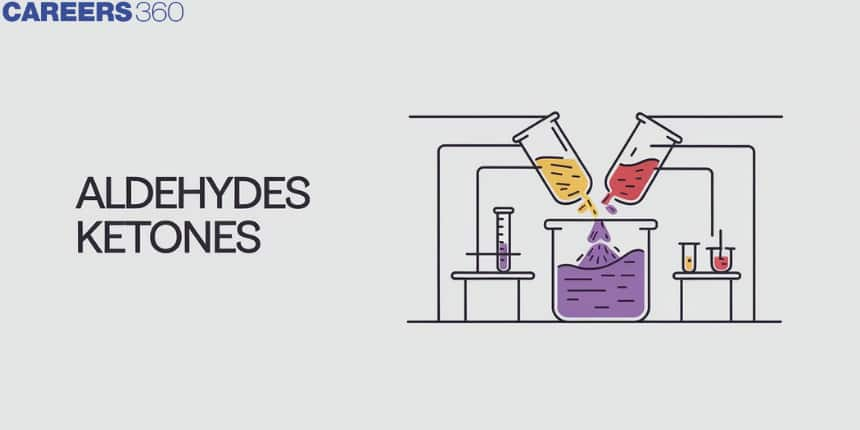Aldehydes Ketones: Overview, Reactions, Physical Properties, Uses, FAQs
Ketones and aldehydes both include the carbonyl functional group or C=O. These are organic compounds having the structural formulas -CHO and RC(=O)R', where R and R', respectively, stand for substituents that contain carbon.
This Story also Contains
- What Are Aldehydes And Ketones
- Aldehydes And Ketones Reactions
- Physical Properties Of Aldehyde And Ketone
- Uses Of Aldehyde
- Uses Of Ketones
- Conclusion

What Are Aldehydes And Ketones
Aldehyde Structure:
One hydrogen atom and either a second hydrogen atom or a hydrogen group, which may be an alkyl group or one containing a benzene ring, are connected to the carbonyl group in aldehydes.
Ketone Structure:
Two hydrocarbon groups are joined to the carbonyl group in ketones. These can either have alkyl groups or benzene rings in them. Ketone's carbonyl group is not joined to a hydrogen atom.
Aldehydes And Ketones Reactions
Hydrogen cyanide addition:
Acetaldehyde produces acetaldehyde cyanohydrins when reacting with hydrogen cyanide. The response is:
CH_3CHO+HCN\longrightarrow CH_3CH(OH)CN
![]()
Acetone cyanohydrins are produced when hydrogen cyanide and acetone combine. The response is:
C_3H_6O+HCN\longrightarrow C_4H_7NO
![]()
Grignard reagent addition:
Formaldehyde forms primary alcohol when it reacts with a Grignard reagent. The response is provided below:
CH_2O+R-MgX\longrightarrow RCH_2OH
![]()
Acetaldehyde produces secondary alcohol when it reacts with the Grignard reagent. The response is provided below:
C_2H_4O+R-MgX\longrightarrow R_2CHOH
![]()
Tertiary alcohol is created via the reaction between acetone and the Grignard reagent. The response is provided below:
C_3H_6O+R-MgX\longrightarrow R_3COH
![]()
Reduction Reaction:
Aldehydes or ketones reduce to the corresponding alcohols when they are in the presence of platinum or palladium, and their reactions are listed below:
RCHO\longrightarrow RCH_2OH
![]()
Numerous catalysts, including red phosphorus, hydriodic acid, hydrazine, and potassium hydroxide, can perform the reduction.
Oxidation Reaction:
Aldehydes and ketones undergo oxidation to produce their corresponding carboxylic acids. The following are the responses:
CH_3CHO+O_2\longrightarrow CH_3CO_2H
![]()
C_3H_6O+O_2\longrightarrow CH_3CO_2H
![]()
Halogenation Reaction:
Aldehydes and ketones also produce the halogenation reaction described below.
CH_3CHO+Cl_2\longrightarrow ClCH_2CHO
![]()
C_3H_6O+Cl_2\longrightarrow ClCH_2COCH_3
![]()
Physical Properties Of Aldehyde And Ketone
Methane has a boiling point of -19° C and ethane has a boiling point of +21°C. This indicates that ethanal's boiling point is rather near to that of room temperature. Aldehydes and ketones often have higher boiling points as their molecular weight rises. This is so because the strength of the intermolecular forces affects the boiling point.
Aldehydes and ketones are soluble in water, but as the length of the chain increases, so does their solubility. Methanal, ethanal, and propanone are those small-molecule aldehydes and ketones that are almost always miscible with water.
Aldehydes and ketones cannot create hydrogen bonds with other aldehydes or ketones, but they can do so with water molecules, which is what allows them to dissolve well in water.
Uses Of Aldehyde
- A gas, formaldehyde is. It produces Formalin, which is used to preserve biological material when mixed with a 40% solution in water.
Uses for formaldehyde include embalming, tanning, making glue and polymeric goods, and treating plants with fungicides, insecticides, and antiseptics. It is also utilised in photography and drug testing.
Formaldehyde and phenol combine to create Bakelite, a material used in adhesives, coatings, and plastics.
The manufacture of acetic acid and pyridine derivatives mostly uses acetaldehyde.
In colours, cosmetics, and perfumes, benzaldehyde is employed. In addition to being employed as a bee repellant, it gives food goods an almond flavour.
Uses Of Ketones
Acetone, the most prevalent ketone, is a fantastic solvent for many polymers and synthetic fibres.
Acetone is a paint thinner and nail polish remover commonly used in households.
It is utilised in medicine for chemical peeling and acne treatments.
Chemically butanone, methyl ethyl ketone (MEK) is a typical solvent. It is employed in the creation of paraffin wax, paint thinner, textile varnishes, polymers, and other products.
Because of its ability to dissolve materials, MEK is also utilised as a welding agent for plastics.
Another significant ketone is cyclohexanone, which is principally employed in the manufacture of nylon.
Conclusion
Ketones stop the oxidation of aldehydes, which swiftly turns them into carboxylic acids. One of the organic compounds that oxidise the most quickly is aldehydes. They are easier to find because of how easily they oxidise. Ketone and aldehyde boiling points were more important than those of non-polar compounds.
Frequently Asked Questions (FAQs)
During substitution processes, the two alkyl/aryl groups in ketones provide a steric hindrance. The hydrogen atom hardly poses any steric obstacles due to its modest size. Aldehydes are more prone to nucleophilic substitutions for this main reason. Additionally, the two R groups in ketones stabilise the carbonyl carbon's partly positive charge.
In contrast to the carbonyl carbon of a ketone, which is connected to two alkyl or aryl groups, the carbonyl carbon of an aldehyde has a hydrogen atom attached to it. Aldehydes are readily oxidizable due to the C-H bond (they are strong reducing agents).
Aldehydes and ketones are frequently found in nature when combined with other functional groups. In microorganisms or plants, you can find substances like cinnamaldehyde (found in cinnamon bark), vanillin (found in vanilla beans), Citra (found in lemongrass), helminthosporal (a fungus toxin), carvone (found in spearmint and caraway), and camphor (found in camphor trees). Contrarily, substances like cortisone (adrenal hormone), testosterone (male sex hormone), progesterone (female sex hormone), and muscone (musk deer) have both animal and human origins.
Ketones are more polar than aldehydes due to two R-groups that donate electrons. The higher boiling points of ketones are explained by the dipole moments resulting from this polarity.
Acetone is utilised as a paint thinner and nail polish remover, whereas ketones are excellent solvents for industry use. Additionally, they are employed in paint thinner, paraffin wax, fabrics, varnishes, plastics, and pharmaceuticals.